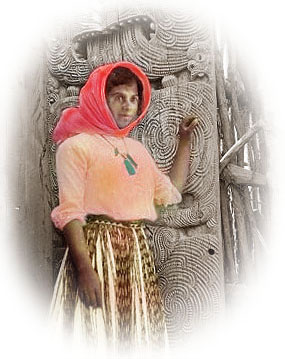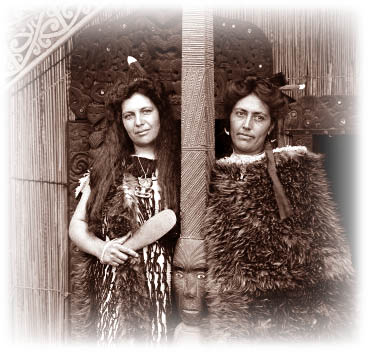
| Pākete
whero Ma-u mai a koe Mā-ku e here Ka tino pai rawa e. |
The
red scarf |
In 1905, guides in the Rotorua thermal area wore red headscarves. Bella's lover wore a red kerchief round his neck. |
| Hoatu
koe kei mua Hinemoa Tīriti Ko au kei muri Kei mātauria |
You
go in front down Hinemoa Street I walk along behind lest our secret becomes known. |
Hinemoa Street led to a lakeside reserve with secluded places where lovers could meet. |
| He
rau koikoi Tō whārikiriki He rau toromiro Tō pēra o runga e |
Soft
pink fern leaves are your bed-mat and miro leaves your pillow. |
Koi-koi
or Ki-o-ki-o, a tiny soft fern Blechnum minus. |
| Tō
pikitanga Taumata te Rāiti. Tō heketanga Ko tara pounamu e |
Your
ascent brings an explosion of light. Your descent brings peaceful intimacy * |
A description of their love-making |
* Tara pounamu has multiple meanings - see below
Pakete Whero
This poi action song has been famous at Whakarewarewa since the early 1900s. It was listed in the program of a 1910 concert organised by Maggie and Bella Papakura. Bella is said to have composed this song in honour of a man from Ruatāhuna that she was secretly having an affair with. The wearing of the red scarves by both of them signaled to each other their secret love. (Paringatai 2004)
A Whaka guide from the 1930s, Bubbles Mihinui, explains:
"It used to be a special song sung by the Whaka guides. Bella composed a poi to this song for the 1934 Waitangi Day celebrations. For a long time only the guides at Whaka could perform it, because 'Pakete whero' has got an offbeat. Bella made her poi sound like the hoof beats of galloping horses - she loved the races."This poi blended aspects of Māori composition (innuendo about a secret love is often a feature of waiata) with European technique (the fast paced off-beat poi rhythms based on galloping horses).It was a "poi waka," designed to satisfy the 1900s Rotorua tourist market. The Whakarewarewa Thermal Area guides had turned to organising concert performance parties to increase their income, and Guide Bella in particular quickly honed her poi skills. She took poi to new levels of performance that were based on a mix of traditional conventions and modern practices, and in doing so created styles that quickly became widespread.
Guide Bella Papakura
Ihapera (Isabella) Thom, who was later widely known as Guide Bella Papakura, was born in the Bay of Plenty in the early 1870s. Her father was an Englishman, William Arthur Thom, a storekeeper who later worked in the Magistrate's Courts at Rotorua and Wairoa, and her mother was Pia Ngarotu Te Rihi, a high-born Te Arawa woman of Ngati Wahiao hapu of Tuhourangi.
Ihapera probably received an education similar to that of her younger sister Maggie, who went to schools in Rotorua and Tauranga, and to Hukarere Native Girls' School, Napier. On leaving school, she went to live at Whakarewarewa, the ancestral home of her people.
Maggie and Bella Papakura in about 1910Under the experienced eye of Guide Sophia Hinerangi, Bella became an accomplished hostess and entertainer, with a special talent for waiata and poi. She developed leadership skills by managing the concert parties established by her sister Maggie.
The family name changed from the dull-sounding Thom to the more romantic Papakura when a tourist asked Maggie what her surname was in Maori. Maggie glanced round for inspiration and saw the geyser Papakura bubbling away nearby. The tourists accepted the name, but Maggie's friends erupted in gales of laughter when they heard her recount the story. She was Maggie Papakura to her friends from that day onward, and Bella was given the name too.
In 1910 Bella and Maggie and their cultural group were invited took part in a Sydney exhibition, giving concert performances and setting up a model Maori village.
In 1911 a touring party consisting of around 40 members of their extended family left for a similar visit to London. They appeared at various venues including the Crystal Palace and White City and entertained thousands of visitors with songs, dances and story-telling.In the 1930s, as the senior guide at Whakarewarewa, Bella would walk behind the apprentice guides, quietly correcting them as they went.
"Bella was in the background all the time," recalled Guide Bubbles Mihinui, "Teaching in her own quiet way. She hated the word 'tourist.' She told us to treat any stranger to our place as manuhiri a visitor. Body language, that's what Bella used to get her point across. Every single one of her visitors were able to relate to her without any words at all."
Click to watch
Multimedia: History of Poi
Tarapounamu / tara pounamu
Tarapounamu is a mountain peak east of Ruatahuna, the home of Bella's lover. It was so named when Tamatea Kaitaharuahe speared a pigeon there in the mid 1600s. The valuable greenstone point on his bird spear become detached from the shaft, and the bird flew away with the point sticking in its body. Tamatea somehow managed to follow the bird for miles across the ranges and eventually recovered his tara pounamu. Tuhoe bird spears
Bella is implyng she was that pigeon, and she is also making some wordplay on the words "tara" and "pounamu" to sum up her feelings after being with him.
"Tara" has several meanings: it can be a spike or spear tip, and thus it is used as a colloquial term for the penis. "Tara" also describes the side walls between two houses, and so it is sometimes used as a term for the vagina.
"Tatau pounamu," a door of greenstone , is a metaphor for enduring peace. Greenstone carvings were beautiful and everlasting and were exchanged as symbols of peace. Pounamu. So by using a variant of this phrase, "tara pounamu," a sexual organ of greenstone, Bella describes the feeling of utter peace she experienced after she and her lover gifted their sexuality to each other.
Pakete Whero on Record
| 1927 | Ana Hato | 78 |
| 1955 | Guide Rangi and the Arawa Concert Party | LP |
| 1956 | Aotearoa Maori Concert Party | LP |
| 1960 | Meet the Maori | LP |
| 1961 | Memories of Maoriland | LP |
| 1965 | NZ Army Concert party | LP |
| 1965 | The Voices of Mokoia | LP |
| 1965 | Ohinemutu Cultural Group. | 45 |
| 1965 | QVS and St. Stephen's Schools. | LP |
| 1967 | Traditional music of the Maori | LP |
| 1975 | New Zealand Maori Chorale | cass |
| 1976 | Haeremai ki au, Kiwi Pacific | cass |
| 1985 | Geyserland Maori Cultural Group | cass |
| 1989 | Music of New Zealand. Vol 2 | CD |
| 1992 | Meet the Maori | CD |
| 1992 | Howard Morrison, Songs Of New Zealand | CD |
| 1993 | Rotorua International Maori Entertainers. | CD |
| 1995 | Traditional music of the Maori | CD |
| 2000 | Ngati-Rongomai Concert Party | CD |
| 2002 | A century of Maori song | CD |
| - - - - | Maori Concert | CD |
| 2003 | Te Roopu Manaia | CD |
| 2004 | Rotorua International Maori Entertainers | CD |
Variations
Rikihana and Paringatai give the coherent story-telling version.
Freedman and Southern give a later, and more easy-to-sing version, with more repetition in it.
| Rikihana 1988 | Paringatai 2004 | Freedman 1965 | Southern 2002 |
|
Pākete
whero |
Pākete
whero Ma-u mai a koe Mā-ku e here Ka tino pai rawa e. |
Pakete
whero Ma-u mai a koe Ma-ku e here Ka tino pai rawa e. |
Pakete
whero Ma-u mai a koe Ma-ku e here Ka tino pai rawa e. |
| Hoatu
koe kei mua Hinemoa Tīriti Ko au kei muri E/Ka mātauria |
Hoatu
koe kei mua Hinemoa Tīriti Ko au kei muri Kei mātauria |
Pakete
whero Ma-u mai a koe Ma-ku e here Ka tino pai rawa e |
Pakete
whero Ma-u mai a koe Ma-ku e here Ka tino pai rawa e |
| He rau
koikoi Tō whārikiriki He rau toromiro Tō pēra o runga e |
He rau
koikoi Tō whārikiriki He rau toromiro Tō pēra o runga e |
Tō
pikitanga Tau mata te rāiti. Tō heketanga Ko Tara pounamu e |
Tō
pikitanga Tau mata te rāiti. Tō heketanga Ko Tara pounamu e |
| Tō
pikitanga Tahunatia te raiti Tō heketanga Ko tarapounamu e |
Tō
pikitanga Taumata te Rāiti. Tō heketanga Ko Tarapounamu e |
Hoatu
koe i mua Hinemoa tīriti Ko ahau kei muri hei mātauria |
Hoatu
koe i mua Hinemoa tīriti Ko ahau kei muri hei mātauria |
Bibliography
Paringatai, K, 2004
Poia mai taku poi, Unearthing the knowledge of the past
A critical review of written literature on the poi in New Zealand and the Pacific
Thesis for Master of Arts, Otago University PDF
Home
Maori
songs Kiwi songs
Search
Published on
the internet, 1 July 2007, reformatted Jan 2022
